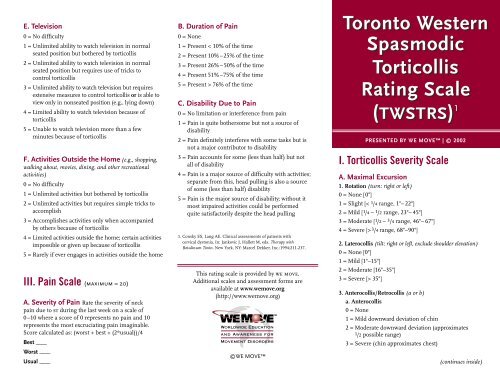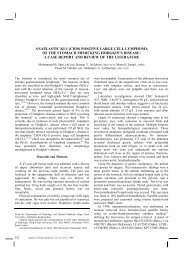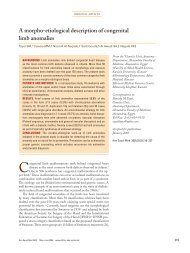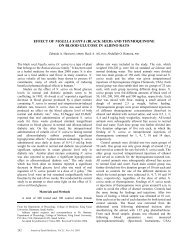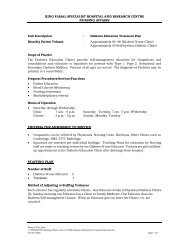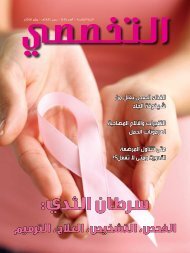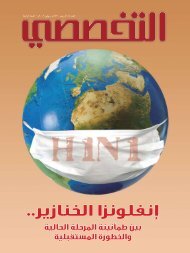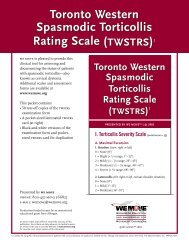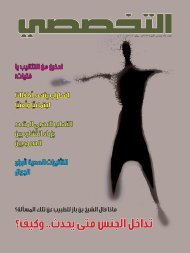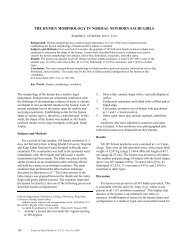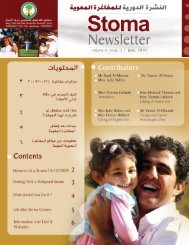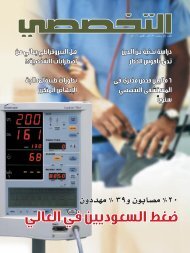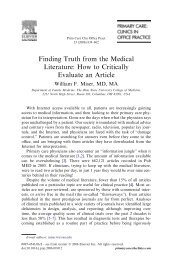Toronto Western Spasmodic Torticollis Rating Scale Toronto ...
Toronto Western Spasmodic Torticollis Rating Scale Toronto ...
Toronto Western Spasmodic Torticollis Rating Scale Toronto ...
Create successful ePaper yourself
Turn your PDF publications into a flip-book with our unique Google optimized e-Paper software.
E. Television<br />
0 = No difficulty<br />
1 = Unlimited ability to watch television in normal<br />
seated position but bothered by torticollis<br />
2 = Unlimited ability to watch television in normal<br />
seated position but requires use of tricks to<br />
control torticollis<br />
3 = Unlimited ability to watch television but requires<br />
extensive measures to control torticollis or is able to<br />
view only in nonseated position (e.g., lying down)<br />
4 = Limited ability to watch television because of<br />
torticollis<br />
5 = Unable to watch television more than a few<br />
minutes because of torticollis<br />
F. Activities Outside the Home (e.g., shopping,<br />
walking about, movies, dining, and other recreational<br />
activities)<br />
0 = No difficulty<br />
1 = Unlimited activities but bothered by torticollis<br />
2 = Unlimited activities but requires simple tricks to<br />
accomplish<br />
3 = Accomplishes activities only when accompanied<br />
by others because of torticollis<br />
4 = Limited activities outside the home; certain activities<br />
impossible or given up because of torticollis<br />
5 = Rarely if ever engages in activities outside the home<br />
III. Pain <strong>Scale</strong> (maximum = 20)<br />
A. Severity of Pain Rate the severity of neck<br />
pain due to st during the last week on a scale of<br />
0 –10 where a score of 0 represents no pain and 10<br />
represents the most excruciating pain imaginable.<br />
Score calculated as: (worst + best + (2*usual))/4<br />
Best ____<br />
Worst ____<br />
Usual ____<br />
B. Duration of Pain<br />
0 = None<br />
1 = Present < 10% of the time<br />
2 = Present 10% –25% of the time<br />
3 = Present 26% – 50% of the time<br />
4 = Present 51% –75% of the time<br />
5 = Present > 76% of the time<br />
C. Disability Due to Pain<br />
0 = No limitation or interference from pain<br />
1 = Pain is quite bothersome but not a source of<br />
disability<br />
2 = Pain definitely interferes with some tasks but is<br />
not a major contributor to disability<br />
3 = Pain accounts for some (less than half) but not<br />
all of disability<br />
4 = Pain is a major source of difficulty with activities;<br />
separate from this, head pulling is also a source<br />
of some (less than half) disability<br />
5 = Pain is the major source of disability; without it<br />
most impaired activities could be performed<br />
quite satisfactorily despite the head pulling<br />
1. Consky ES, Lang AE. Clinical assessments of patients with<br />
cervical dystonia. In: Jankovic J, Hallett M, eds. Therapy with<br />
Botulinum Toxin. New York, NY: Marcel Dekker, Inc.:1994;211-237.<br />
This rating scale is provided by we move.<br />
Additional scales and assessment forms are<br />
available at www.wemove.org<br />
(http://www.wemove.org)<br />
©WE MOVE<br />
<strong>Toronto</strong> <strong>Western</strong><br />
<strong>Spasmodic</strong><br />
<strong>Torticollis</strong><br />
<strong>Rating</strong> <strong>Scale</strong><br />
(TWSTRS) 1<br />
PRESENTED BY WE MOVE | © 2002<br />
I. <strong>Torticollis</strong> Severity <strong>Scale</strong><br />
A. Maximal Excursion<br />
1. Rotation (turn: right or left)<br />
0 = None [0°]<br />
1 = Slight [< 1/4 range, 1°– 22°]<br />
2 = Mild [ 1 /4 – 1 /2 range, 23°– 45°]<br />
3 = Moderate [ 1 /2 – 3 /4 range, 46°– 67°]<br />
4 = Severe [> 3 /4 range, 68°–90°]<br />
2. Laterocollis (tilt: right or left, exclude shoulder elevation)<br />
0 = None [0°]<br />
1 = Mild [1°–15°]<br />
2 = Moderate [16°–35°]<br />
3 = Severe [> 35°]<br />
3. Anterocollis/Retrocollis (a or b)<br />
a. Anterocollis<br />
0 = None<br />
1 = Mild downward deviation of chin<br />
2 = Moderate downward deviation (approximates<br />
1/2 possible range)<br />
3 = Severe (chin approximates chest)<br />
(continues inside)
. Retrocollis<br />
0 = None<br />
1 = Mild backward deviation of vertex with upward<br />
deviation of chin<br />
2 = Moderate backward deviation (approximates 1 /2<br />
possible range<br />
3 = Severe (approximates full range)<br />
4. Lateral shift (right or left)<br />
0 = Absent<br />
1 = Present<br />
5. Sagittal shift (forward or backward)<br />
0 = Absent<br />
1 = Present<br />
B. Duration Factor (Weighted x 2)<br />
0 = None<br />
1 = Occasional deviation (< 25% of the time,<br />
most often submaximal)<br />
2 = Occasional deviation (< 25% of the time,<br />
often maximal) or<br />
Intermittent deviation (25% –50% of the time,<br />
most often submaximal)<br />
3 = Intermittent deviation (25% –50% of the time,<br />
often maximal) or<br />
Frequent deviation (50% –75% of the time,<br />
most often submaximal)<br />
4 = Frequent deviation (50% –75% of the time,<br />
often maximal) or<br />
Constant deviation (>75% of the time,<br />
most often submaximal)<br />
5 = Constant deviation (>75% of the time,<br />
often maximal)<br />
C. Effect of Sensory Tricks<br />
0 = Complete relief by one or more tricks<br />
1 = Partial or only limited relief by tricks<br />
2 = Little or no benefit from tricks<br />
D. Shoulder Elevation/Anterior Displacement<br />
0 = Absent<br />
1 = Mild (< 1 /3 possible range, intermittent or constant)<br />
2 = Moderate ( 1 /3 – 2 /3 possible range and constant,<br />
> 75% of the time) or<br />
Severe (> 2/3 possible range and intermittent)<br />
3 = Severe and constant<br />
E. Range of Motion (without aid of sensory tricks)<br />
0 = Able to move to extreme opposite position<br />
1 = Able to move head well past midline but not to<br />
extreme opposite position<br />
2 = Able to move head barely past midline<br />
3 = Able to move head toward but not past midline<br />
4 = Barely able to move head beyond abnormal posture<br />
F. Time (up to 60 seconds) for which patient is able to<br />
maintain head within 10° of neutral position without using<br />
sensory tricks (mean of two attempts)<br />
0 = > 60 seconds<br />
1 = 46–60 seconds<br />
2 = 31–45 seconds<br />
3 = 16–30 seconds<br />
4 = < 15 seconds<br />
II. Disability <strong>Scale</strong> (maximum = 20)<br />
A. Work (occupation or housework/home management)<br />
0 = No difficulty<br />
1 = Normal work expectations with satisfactory<br />
performance at usual level of occupation but some<br />
interference by torticollis<br />
2 = Most activities unlimited, selected activities very<br />
difficult and hampered but still possible with<br />
satisfactory performance<br />
3 = Working at lower than usual occupation level; most<br />
activities hampered, all possible but with less than<br />
satisfactory performance in some activities<br />
4 = Unable to engage in voluntary or gainful<br />
employment; still able to perform some domestic<br />
responsibilities satisfactorily<br />
5 = Marginal or no ability to perform domestic<br />
responsibilities<br />
B. Activities of Daily Living (e.g., feeding, dressing,<br />
or hygiene, including washing, shaving, makeup, etc.)<br />
0 = No difficulty with any activity<br />
1 = Activities unlimited but some interference by<br />
torticollis<br />
2 = Most activities unlimited, selected activities very<br />
difficult and hampered but still possible using<br />
simple tricks<br />
3 = Most activities hampered or laborious but still<br />
possible; may use extreme tricks<br />
4 = All activities impaired; some impossible or require<br />
assistance<br />
5 = Dependent on others in most self-care tasks<br />
C. Driving<br />
0 = No difficulty (or has never driven a car)<br />
1 = Unlimited ability to drive but bothered by torticollis<br />
2 = Unlimited ability to drive but requires tricks<br />
(including touching or holding face, holding head<br />
against head rest) to control torticollis<br />
3 = Can drive only short distances<br />
4 = Usually cannot drive because of torticollis<br />
5 = Unable to drive and cannot ride in a car for long<br />
stretches as a passenger because of torticollis<br />
D. Reading<br />
1 = Unlimited ability to read in normal seated position<br />
but bothered by torticollis<br />
2 = Unlimited ability to read in normal seated position<br />
but requires use of tricks to control torticollis<br />
3 = Unlimited ability to read but requires extensive<br />
measures to control torticollis or<br />
is able to read only in nonseated position (e.g., lying<br />
down)<br />
4 = Limited ability to read because of torticollis despite<br />
tricks<br />
5 = Unable to read more than a few sentences because<br />
of torticollis<br />
(continues on back)


